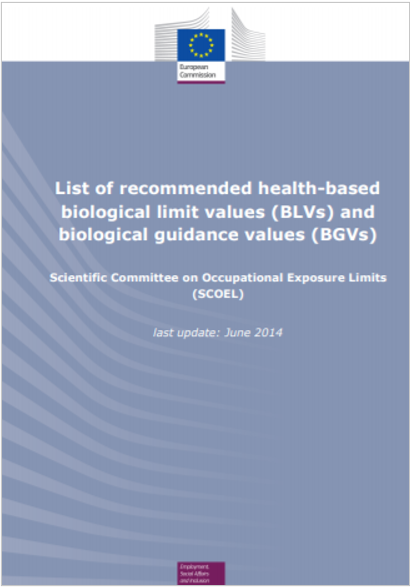List of recommended health-based biological limit values (BLVs)
| ID 11185 | | Visite: 3023 | Documenti Sicurezza UE | Permalink: https://www.certifico.com/id/11185 |
List of recommended health-based biological limit values (BLVs)
List of recommended health-based biological limit values (BLVs) and biological guidance values (BGVs) Scientific Committee on Occupational Exposure Limits (SCOEL)*
Biological monitoring Under certain circumstances biological monitoring offers advantages over air monitoring in assessing risk to health, e.g. for substances with a significant skin uptake. For such compounds, biological monitoring may be preferable, if suitable methods are available. SCOEL evaluates the need to recommend biological monitoring for particular substances on a case-by-case basis and recommends biological values based on the currently available scientific data. Health-based biological limit values (BLVs) Biological limit values (BLVs) are reference values for evaluating potential health risks in the practice of occupational health.
A BLV is a guideline for the control of such risks and should not be used for other purposes. Due to biological variability, an individual’s measurement may exceed the BLV without incurring an increased health risk. If, however, the biological levels persistently exceed the BLV, or if the majority of measurements obtained from a group of workers at the same workplace exceed the BLV, the cause of the excessive values must be investigated and proper action taken to reduce the exposure.
Exposure equivalent to the BLV generally do not affect the health adversely, when attained regularly under workplace conditions, except in cases of hypersensitivity. In the first instance, BLVs represent the levels of determinants which are most likely to be observed in specimens collected from a worker exposed to the chemical in question exclusively by inhalation at the level of the occupational exposure limit (OEL).
Exceptions are BLVs for substances for which the OELs serve as protection against non-systemic effects (e.g. irritation or respiratory disorders) or for substances which require biological monitoring due to other routes of absorption, in particular the skin. Biological guidance values (BGVs) Where toxicological data cannot support a health-based BLV, a biological guidance value (BGV) might be established. This value represents the upper concentration of the substance or a metabolite of the substance in any appropriate biological medium corresponding to a certain percentile (generally 90 or 95 percentile) in a defined reference population.
If background levels cannot be detected, the BGV may be equivalent to the detection limit of the biomonitoring method, which then is to be specified in the document.
A value exceeding the BGV might help to identify the need for an expert consideration of the working conditions. Unlike BLVs, BGVs are not healthbased and therefore do not set a limit between absence or presence of adverse health effects.
* Lo SCOEL è stato sostituito dal RAC (Risk Assessment Committee dell’ECHA)
| Descrizione | Livello | Dimensione | Downloads | |
|---|---|---|---|---|
| SCOEL Recommended BLVs-BGVs June 2014.pdf EC 2014 |
442 kB | 24 |
